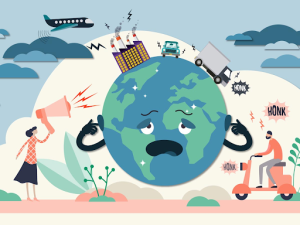16 Sep Noise a polluting agent
Noise Pollution in India
Severe Noise Pollution Impacts on Humans and wildlife. The article tells about the significance of pollution on the Environment and Climate Change.
Context: Over 900 challans were issued by Delhi Traffic Police to commuters using pressure horns and modified silencers in their vehicles.

Pic: Noise Pollution
What is noise pollution?
Noise pollution can be defined as any disturbing or unwanted noise that interferes with or harms humans or wildlife.
What is the permissible level of noise?
- Rules have been defined by the Central Pollution Control Board (CPCB) regarding noise levels in India for different areas.
(i) the acceptable levels of noise across areas during daytime and night time. Daytime comprises 6 am to 10 pm, and night is 10 pm to 6 am.
(ii) In industrial areas, the permissible limit is 75 dB for daytime and 70 dB at night.
(iii) In commercial areas, it is 65 dB and 55 dB, while in residential areas it is 55 dB and 45 dB during daytime and night respectively.
- In addition to this, state governments have assigned some ‘silent zones’ which include areas that lie within 100 meters of the premises of schools, colleges, hospitals, and courts. The permissible noise limit in this zone is 50 dB during the day and 40 dB during the night.
Regulating the body:
The Noise Pollution (Regulation and Control) Rules, 2000:
- According to Section 2 (a) of the Air (Prevention and Control of Pollution) Act, 1981 noise is considered an ‘air pollutant’.
- As per the reports, an “air pollutant” is any solid, liquid, or gaseous substance, including noise, present in the atmosphere in such concentrations as to be or tend to be harmful to humans, other living creatures, plants, property, or the environment.
- Prior to this, the pollution and its sources were addressed under the Air (Prevention and Control of Pollution) Act, 1981. Noise pollution and its sources are regulated under the Pollution (Regulation and Control) Rules, 2000 under The Environment (Protection) Act, 1986.
- Under the Act, there is a defined ambient acceptable noise level, restrictions on the use of loudspeakers, sound-emitting construction equipment, horns, bursting of crackers, and so on.
NGT’s role in it?
- The NGT has passed an order to CPCB to categorize cities on the basis of their noise profile and identify the noisy hotspots.
- The CPCB has also been asked to propose remedial plans for the pollution, within 3 months.
- NGT has also called upon police departments in all states to procure sound monitoring devices.
- They have also been directed to assist the pollution control authorities in their efforts to control noise pollution in the nation.
- Manufacturers of public address systems and sound amplification equipment should provide inbuilt noise meters and data loggers in their products.
- This would help regulators to establish violations and fix responsibilities.
Main causes of noise pollution?
Noise pollution is mainly caused by vehicles, aircraft, industrial machines, loudspeakers, crackers, etc., and can put so many ill effects on the life of humans, animals, and birds.
Some of the main causes of pollution are,
Not properly planned areas :
Improper and poor urban planning plays a major role in creating noise pollution, mostly in developing countries due to congested houses, small spaces, poor parking facilities, and frequent fights over basic amenities which disrupt the environment of society.
- Construction Sites:
Various construction activities which include mining, and the construction of bridges, dams, buildings, etc contribute greatly to creating pollution.
- Industrialization:
The growing industries in urban areas are a major cause of noise pollution these days which use various machines that are capable of generating a large amount of noise.
loudspeakers :
In several social events, songs are often played at full volume by the people which makes the living condition pretty much worse thus creating pollution. Weddings and public gatherings involve loudspeakers playing music resulting in the production of unwanted noise in the neighborhood.
How Harmful is noise pollution?
To human
- Hypertension: Longer exposure to loud noise result in elevated blood levels which can cause hypertension in humans.
- Hearing Disability: Constant exposure to loud noise which is beyond the range of normal sound intensity can damage the eardrums, thus resulting in hearing disability.
- Sleeping disorders: Noise pollution can also affect the sleep cycle of an individual which may lead to sleeping disorders, low energy levels, and fatigue.
- Cardiovascular issues: Loud noises also results in an increase in normal blood pressure level and cause several cardiovascular diseases in a normal person.To animals and birds :
In Ocean
- Higher noise levels can reduce the ability of animals to communicate with potential mates, other group members, their offspring, or feeding partners.
- Noise can also reduce an ocean animal’s ability to hear environmental cues that are vital for survival, including those key to avoiding predators, finding food, and navigating to preferred habitats.
Impact on other species:
Traffic and other urban noises disturb and endanger the survival of other species. For example, Audile signals are used in a variety of communication contexts by animals like territory defense, warning of danger, locating or attracting a mate, and caring for offspring. However, these functions are severely hindered by noise pollution.
- Many species tend to adapt to pollution by altering their behavior, for example, changing their signals by switching their vocal frequency or altering their vocalization timing. Nevertheless, these adaptations can have unintended consequences (like altered vocalization patterns may be considered less attractive by potential mating partners, therefore affecting reproductive success). These consequences might eliminate them from their habitats, with possible significant ecological implications
Measure to mitigate the pollution.
- Highway traffic should be diverted to bye-pass roads and over-bridges and should not be allowed to pass through towns and cities. Pressure horns should be banned.
- Noise-making machines should be installed in soundproof chambers in industries. Proper lubrication and maintenance of machines should be done to reduce noise at proper time intervals.
- Protective devices like ear muffs or cotton plugs should be provided to workers working in noisy installations.
- Green belts policy should be applied to grow trees and shrubs along roads, rails, and around industrial areas and residential complexes in order to decrease the intensity of the sound. These belts reduce the noise level by 10-15 dB. Trees like Neem, Ashoka, Tamarind, etc. help reduce pollution by absorbing sound.
- Enforcing acoustic zoning by keeping human settlements away from noise-producing industries, aerodromes, railway stations, etc. Silence zones should be created for educational institutes, hospitals, and important offices.

Pic: Measure to mitigate noise pollution
Legal measures were taken against noise pollution in India.
- Excessive noise has been registered as a crime (Section 268 of IPC).
- Noise Pollution (Regulation and Control) Rules, 2000 have been notified.
- Noise has been recognized as a pollutant (Environment Act 1986).
- Day and night limits of noise level have been prescribed.
- A 100-meter radius area around hospitals, educational institutions, and courts has been declared a ‘Silence Zone’ where the use of horns, loudspeakers, and bursting of crackers is banned.
- The use of loudspeakers is a public nuisance and is punishable under section 133 of IPC.
- There are provisions related to the pollution under Motor Vehicle Act, Factories Act, Railways Act, and Aircraft Act
Source:
IAS Current Affairs: For getting important news of the national and international world, follow the Plutus IAS daily current affairs site. It helps you to prepare for the UPSC examination. We provide moderated and best daily current affairs for the UPSC examination free of cost. You also get Weekly and Monthly current affairs for the IAS examination from us.



No Comments